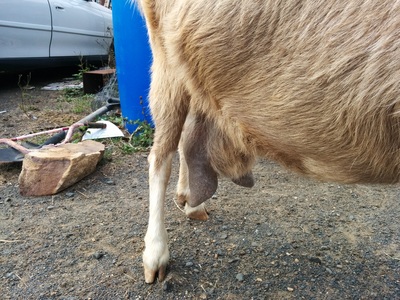
We have a heavily pregnant, 'organic' goat with only 1 month to kidding date. She is a 6-litre-a-day Toggenburg doe. We tried to do the right thing by the goat to give her a break from milking and to let her developing kids get the nutrition they need from their mother before being born. While we weren't successful in properly drying up our goat's milk, we were successful in inadvertently helping her come down with a severe case of mastitis. our poor goat! She became feverish and her udder also was very hot to touch and we felt hard lumps in her udder. Her milk had become very thick and we could not milk one of her teats out for more than 3 small squirts. Our poor doe was in pain when we gently massaged her udder to try to break up the lumps. As the doe was heavily pregnant, we were cautious about using antibiotics so we were motivated to avoid using them if at all possible. We consulted with our vet and got the antibiotics just in case the natural alternatives that we wanted to try, didn't work quickly enough to keep the doe comfortable. Firstly we prepared a cabbage leaf and potato poultice which we strapped onto her udder using a pair of pantyhose to take out the heat and to start breaking up the lumps. (see photo). This was a major engineering feat! After the poultice, we treated her teats with diluted antimicrobial essential oil infusions which were syringed into both teats (not using the sharp needle, but just the plastic syringe tip which did not cause her pain). We also gave her a drench, (similar to the Pat Coleby treatment) made up o: 1 x dessertspoon of of Vit C powder (sodium ascorbate) and the same amount of dolomite. We added 10 ml of TNN minerals for sheep and goats and 20 ml of apple cider vinegar and some molasses to make the drench more palatable. We gave this mixture orally, dissolved in 40cc of water. We rubbed diluted antimicrobial essential oils on the doe's udder and gave her about 15 drops of the same oil mixture in an oral drench too. The essential oils are 'hot' oils and had to be VERY diluted with olive oil before being applied to the doe's udder and drench so that she did not get burned. We also applied apple cider vinegar to the doe's udder, which a goat breeder told us was effective too. After one dose, there was a noticeable improvement. After the third dose it was very marked and we were able to milk the infected teat much more easily, getting about 12 squirts. This was very encouraging to see after only 24 hours on the alternative treatments. The essential oils we used were all from Young Living Essential Oils: oregano, peppermint, thyme and wintergreen. These oils contain anti-inflammatory properties and are antimicrobial. The goat is much happier and hopefully she will be totally over the mastitis in time to feed her kids. If not, we have the antibiotics on hand - just in case.
Update Feb 2016
This doe went on to have 3 very healthy kids, two does and a buck. The buckling (Mr Snuggles) was weaned at 4 months of age and went to stud in Northern Territory with 70 does! His new owner informed us that almost all of his progeny looked like pure Toggies (as Mr Snuggles was pure Toggie, registered and pedigreed). In a subsequent pregnancy, the doe again came down with mastitis and was treated with antibiotics both by a series of injections which we administered in the neck for 6 days, according to the vet's directions and also suppositories into the teats. Sadly the mastitis lumps were recurring and the infection was not able to be removed. The doe is now being assessed by university vets for suitability for complete mastectomy. This doe is a very special pet and it is very expensive to have the operation completed and there is risk of the doe going into shock under the anaesthetic, which would be tragic. Check this page for updates.
This doe went on to have 3 very healthy kids, two does and a buck. The buckling (Mr Snuggles) was weaned at 4 months of age and went to stud in Northern Territory with 70 does! His new owner informed us that almost all of his progeny looked like pure Toggies (as Mr Snuggles was pure Toggie, registered and pedigreed). In a subsequent pregnancy, the doe again came down with mastitis and was treated with antibiotics both by a series of injections which we administered in the neck for 6 days, according to the vet's directions and also suppositories into the teats. Sadly the mastitis lumps were recurring and the infection was not able to be removed. The doe is now being assessed by university vets for suitability for complete mastectomy. This doe is a very special pet and it is very expensive to have the operation completed and there is risk of the doe going into shock under the anaesthetic, which would be tragic. Check this page for updates.
The doe has been retired as a breeder and milker and is only now a much loved pet. She is being assessed by university vets for suitability for a complete mastectomy. If successful, the goat would be able to run and move and be free of the recurring abscess infection in her udder that is not responsive to any antibiotics. Check this page for updates!







 RSS Feed
RSS Feed